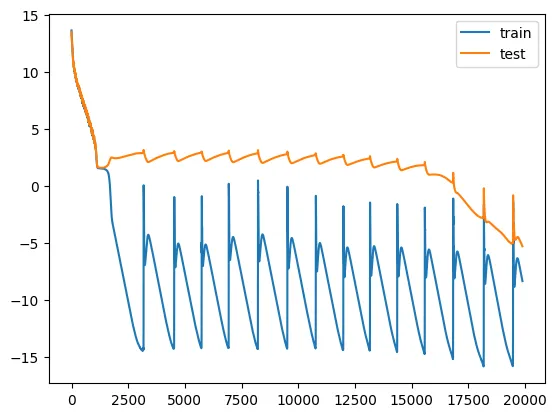Teaching a GPT to Do Modular Addition
from tinygrad import Tensor, dtypes, TinyJit
from tinygrad.nn.optim import AdamW
from tinygrad.nn.state import get_parameters
from tqdm import trange
from math import prod
import matplotlib.pyplot as plt
import numpy as np
mod = 113
train_test_ratio = .3
ds_len = mod * mod
# [[0,1,2,..,mod,0,1,2,...mod] mod times]
a = (
Tensor.arange(mod, dtype=dtypes.int)
.repeat((mod, 1))
.flatten(0, -1)
.unsqueeze(0)
)
# [[0,0,0,...,1,1,1,...,112,112,112] mod times]
b = (
Tensor.arange(mod, dtype=dtypes.int)
.unsqueeze(-1)
.repeat((1, mod))
.flatten(0, -1)
.unsqueeze(0)
)
# [[113, 113, 113,...,113, 113] mod times]
equals = Tensor.full((ds_len), mod).unsqueeze(0)
# [[0+0, 1+0, 2+0, ..., 112+0], [0+1, 1+1, 2+1, ..., 112+112]]
sum = a + b
products = sum.div(mod).floor() * mod
# [[0, 1, 2, ..., 112], [1, 2, 3, ..., 113], ...]
targets = sum - products
ds = a.cat(b, equals, dim=0).T
indices = Tensor.randint(
ds_len,
low=0,
high=ds_len,
)
ds_shuffled = ds[indices].cast(dtypes.float)
targets_shuffled = (
targets[:, indices].cast(dtypes.float).reshape(prod(targets.shape), 1)
)
train_cutoff = int(train_test_ratio * ds_len)
x_train = ds_shuffled[:train_cutoff]
y_train = targets_shuffled[:train_cutoff]
x_test = ds_shuffled[train_cutoff:]
y_test = targets_shuffled[train_cutoff:]
class TransformerBlock:
def __init__(self, embed_dim, head_dim, num_heads):
self.embed_dim = embed_dim
self.head_dim = head_dim
self.num_heads = num_heads
self.q = Tensor.normal(embed_dim, embed_dim)
self.k = Tensor.normal(embed_dim, embed_dim)
self.v = Tensor.normal(embed_dim, embed_dim)
self.head_out = Tensor.normal(num_heads * head_dim, embed_dim)
self.ff1 = Tensor.normal(embed_dim, 4 * embed_dim)
self.ff2 = Tensor.normal(4 * embed_dim, embed_dim)
def attn(self, x):
bsz = x.shape[0]
q, k, v = [
x.linear(proj)
.reshape(bsz, -1, self.num_heads, self.head_dim)
.transpose(1, 2)
for proj in (self.q, self.k, self.v)
]
return (
q.scaled_dot_product_attention(k, v)
.transpose(1, 2)
.reshape(bsz, -1, self.num_heads * self.head_dim)
.linear(self.head_out)
)
def mlp(self, x):
return x.linear(self.ff1).relu().linear(self.ff2)
def __call__(self, x):
x = x + self.attn(x)
x = x + self.mlp(x)
return x
class GPT:
def __init__(self, num_layers=1, embed_dim=128, vocab_size=113, context_length=3, num_heads=4):
self.num_layers = num_layers
self.embed_dim = embed_dim
self.vocab_size = vocab_size
self.context_length = context_length
self.num_heads = num_heads
self.tok_embed = Tensor.normal(vocab_size, embed_dim)
self.pos_embed = Tensor.normal(context_length, embed_dim)
self.blocks = [
TransformerBlock(embed_dim, embed_dim // num_heads, num_heads)
for _ in range(num_layers)
]
self.out = Tensor.normal(embed_dim, vocab_size - 1)
def __call__(self, x):
# input shape (B,T,C)
bsz = x.shape[0]
pos = (
Tensor.arange(self.context_length)
.one_hot(self.context_length)
.cast(dtypes.float)[: x.shape[1]]
.expand((bsz, None, None))
)
x = x.one_hot(self.vocab_size).linear(self.tok_embed) + pos.linear(
self.pos_embed
)
x = x.sequential(self.blocks)
x = x.reshape(-1, x.shape[-1]).linear(self.out)
return x.reshape((bsz, -1, x.shape[-1]))
def loss_fn(logits: Tensor, labels):
log_probs = logits.log_softmax(axis=-1).cast(dtypes.float64)
correct = log_probs.gather(dim=-1, index=labels,)[:, 0]
return -correct.mean()
def train(
model,
X_train,
Y_train,
X_test,
Y_test,
optim,
steps=10000, # Adjust this as per the actual training epochs needed
lossfn=lambda out, y: out.sparse_categorical_crossentropy(y),
allow_jit=True,
):
def train_step(x, y):
out = model(x)[:, -1]
loss = lossfn(out, y)
loss.backward()
optim.step()
optim.zero_grad()
return loss.realize()
def test_step(x, y):
out = model(x)[:, -1]
optim.zero_grad()
loss = lossfn(out, y)
return loss.realize()
if allow_jit:
train_step = TinyJit(train_step)
train_losses = []
test_losses = []
with Tensor.train():
for i in (t := trange(steps)):
train_loss = train_step(X_train, Y_train)
test_loss = test_step(X_test, Y_test)
if test_loss.numpy() < 0.005:
break
train_losses.append(train_loss.numpy())
test_losses.append(test_loss.numpy())
t.set_description(
f"train loss: {train_loss.numpy():.2f}, test loss: {test_loss.numpy():.2f}"
)
return train_losses, test_losses
model = GPT()
optimizer = AdamW(get_parameters(model), lr=1e-3, b1=0.9, b2=0.98, weight_decay=1.0)
train_losses, test_losses = train(
model,
x_train,
y_train,
x_test,
y_test,
optimizer,
steps=50000,
lossfn=loss_fn,
)
train loss: 0.00, test loss: 0.01: 40%|███▉ | 19885/50000 [15:16<23:08, 21.69it/s]
plt.plot(np.log(train_losses), label="train")
plt.plot(np.log(test_losses), label="test")
plt.legend()
plt.show()
This is the famous loss curve (forgive me for the scale of y-axis). I believe the strange periodic behavior is due to numerical instability, but the
idea is there -- we see that the train loss plummets quickly, while the test loss remains constant and only plummets
after tens of thousands of epochs of training.

import pickle
with open('train.pkl', 'wb') as file:
pickle.dump(train_losses, file)
with open('test.pkl', 'wb') as file:
pickle.dump(test_losses, file)